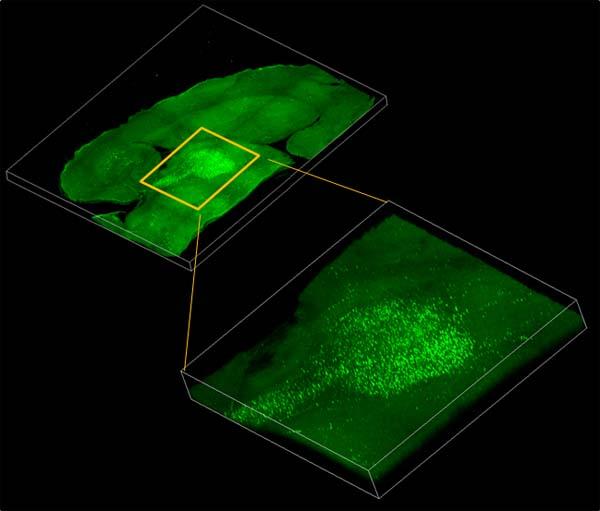
Zeiss 780 Confocal/Spectral/Multiphoton/FLIM Imaging microscopy system [Funded by NIH-OD 016446; 2013]
The Zeiss 780 NLO system consists of an inverted Axio Observer microscope, laser scanning confocal, 32 channels spectral imaging, two channels NDD transmission detectors and two channels non-descan (NDD) epi-fluorescence detectors, motorized stage for automated scanning, and IR Chameleon Vision-II, ultrafast Ti:Sapphire laser for multiphoton excitation. The advantage of this system is the 32-channel descan spectral GaAsP (Gallium Arsenide Phosphide) detector with ~40% quantum efficiency with spectral resolution about 8.7 nm covering the spectral range 415-735 nm. For lambda sequential spectral scanning one can select 2.9 nm or 4.4 nm steps. There are two peltier cooled PMT detectors (located on both sides of the spectral detector) to cover the spectral range from 371-416 nm and 728-758 nm respectively (Figure 1). The Zen operational and data analysis software is very user friendly. The Zeiss Zen software has many functions, including the Multi-Timing Macro, Multicolor+3D+time, FRAP, FRET, tile imaging, multitrack scanning to avoid crosstalk, various image analysis functions (e.g. 3D projection, linear unmixing), etc.
Coupling the Zeiss 780 with a Chameleon Vision-II, ultrafast Ti:Sapphire laser (pre-compensation provides 150 femto second (fs) pulses, digitally tunable range from 680nm to 1080nm, with an average peak power of >2.3 W) will provide an automated dispersion compensation that delivers shorter pulses at the specimen plane. The combination of short pulses at high power level provides brighter images from deep inside tissue specimens or whole animals. The users have the freedom to select the wavelength from the software instead of looking for an expert to tune the required wavelength and stabilize the laser pulse.
Three HPM-100-40 hybrid GaAsP detectors (Becker and Hickl) for FLIM are coupled to the non-descanned port of the microscope using two T-adapters (Zeiss) with proper dichroics and emission filters. Two SPC-150 cards (Becker&Hickl) synchronized with the pulsed laser and the Zeiss LSM-780 scan head signals collect the time-resolved fluorescence in TCSPC mode using SPCM (version 9.74) acquisition software.
Becker & Hickl (B&H) - Time-domain (TD) Two-Photon Three channels Fluorescence lifetime imaging (FLIM) and Correlation Spectroscopy (FCS) systems [Funded by Keck Foundation; 2002]
Becker & Hickl time domain (TD), three-channel FLIM/FCS imaging system, coupled to the Zeiss 780 multiphoton system.
Components & Features
- Automated stage (for screening and tile imaging) and focus.
- Temperature controlled Chamber and Eppendorf microinjection device.
- Objective lenses: 5X/0.16, 10X/0.45, 20X/0.80, 25X/0.80, 40X/1.30 (Oil), 40X/1.10 (water), 63X/1.40 (Oil), 100X/1.40 (oil); Dipping lenses -10X, 20X & 40X
- Excitation lasers: UV 405, Argon-ion laser (458, 488, 514 nm), DPSS 561, HeNe 594, HeNe 633. Coherent Chameleon Vision-II, digitally tunable from 680 to 1080 nm. With dispersion compensation.
- Internal Detectors: 32-channel GaAsP (Gallium Arsenide Phosphide) spectral detector plus one UV and one Red sensitive PMT detectors.
- External Detectors: Two sensitive Transmission NDD PMT detectors and Two NDD fluorescence GaAsP detectors.
- External Detectors for FLIM: Three HPM-100-40 hybrid GaAsP NDD detectors (Becker and Hickl)